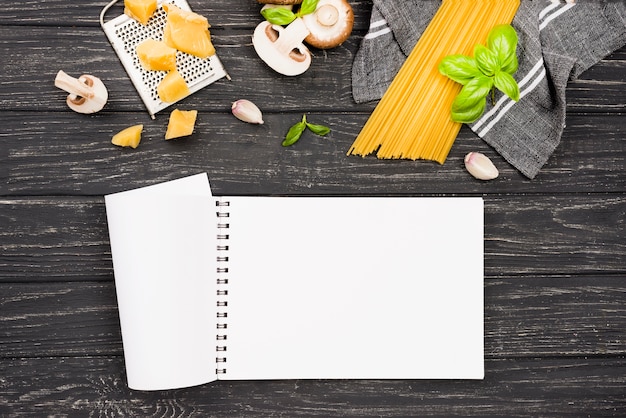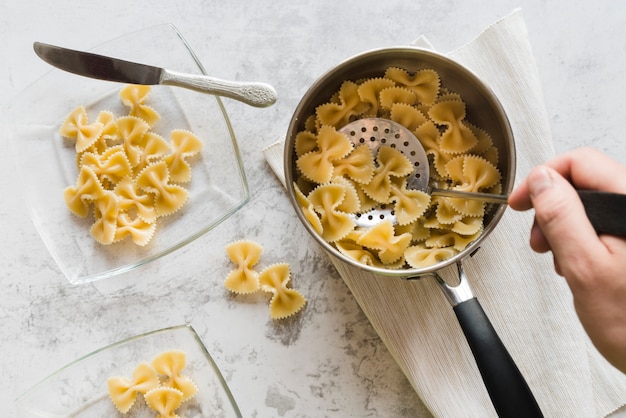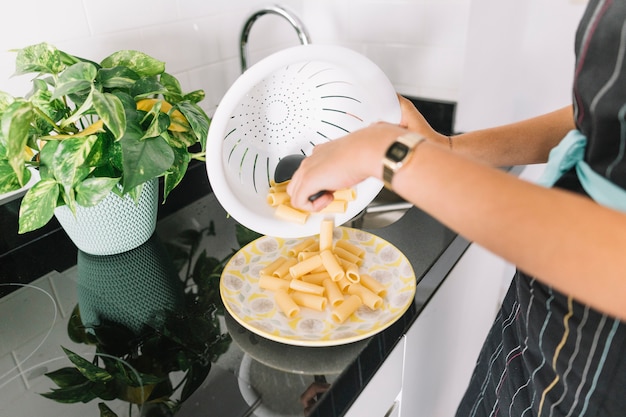Pasta. The mere mention of this word conjures up images of steaming bowls of goodness, family gatherings around a table laden with laughter and conversation, and the comforting aroma of simmering sauce. It's a food that holds a special place in my heart, a culinary canvas on which I've experimented and honed my skills over years of pasta-making adventures. And now, I'm ready to share my passion and knowledge with you, taking you on a journey to pasta perfection, step by delicious step.
(Part 1) The Foundation: Choosing the Right Pasta

The world of pasta is vast and diverse, a veritable symphony of shapes and sizes, each with its unique personality and purpose. But how do you navigate this labyrinth of culinary delights and choose the perfect pasta for your dish? It's all about understanding the shape and its intended role in your pasta symphony.
The Shapes of Pasta: A Guide to Harmony
Let's start with the classics: spaghetti, the long, thin strands perfect for twirling and catching delicate sauces like pesto or a simple tomato sauce. Then there's penne, the short, cylindrical tubes with ridges that hold onto chunky sauces like a hearty bolognese. And then you have the versatile rigatoni, a larger version of penne, equally suited for robust sauces and creamy cheeses.
For something a bit more whimsical, consider orecchiette, the adorable "little ears" that are ideal for capturing the flavours of rich, meat-based sauces. And for a truly decadent experience, there's pappardelle, the wide, flat ribbons that are perfect for pairing with rich, flavorful sauces like a wild boar ragù or a mushroom ragu.
The choice of pasta shape is a critical decision. It influences how the sauce clings to the pasta, how it feels in your mouth, and ultimately, how the entire dish comes together. Think of it as choosing the right instrument for a musical composition. The wrong choice can create discord, while the right choice can bring forth a symphony of flavor.
The Texture Tale: From Delicate to Hearty
Beyond the shape, the texture of the pasta is another crucial factor. Some pastas, like rigatoni, are sturdy and robust, capable of holding their own against hearty sauces and rich cheeses. Others, like angel hair, are delicate and ethereal, best suited for lighter, more delicate sauces.
Think of the texture as the melody of your pasta dish. A delicate pasta needs a lighter sauce, a gentle accompaniment, while a sturdier pasta can handle a more robust sauce, a full-bodied melody.
The fresh pasta Factor: A Culinary Indulgence
I'll admit it: I have a soft spot for fresh pasta. There's something magical about the way it transforms from a simple dough to a delicate, airy creation. The texture is like no other, with a slight chewiness and a lightness that melts in your mouth. It's a culinary indulgence, a testament to the artistry of pasta making.
However, if you're short on time or don't have the equipment for making fresh pasta, don't despair! dried pasta is a fantastic alternative. Just make sure you choose a good quality brand, one that uses high-quality ingredients and doesn't feel overly dry or brittle.
(Part 2) The Art of Al Dente: Mastering the Perfect Cook

Ah, al dente, the holy grail of pasta cooking. It's that magical state where the pasta is cooked through but still has a slight firmness, a delightful "bite" that adds to the overall experience. It's the sweet spot between undercooked and overcooked, the perfect balance that elevates your pasta from ordinary to extraordinary.
The Science of Salted Water: A Culinary Necessity
The journey to al dente begins with a large pot of salted water. The salt isn't just for flavor; it helps season the pasta and prevents it from becoming bland. And don't be shy with the salt! Use a generous amount, about 1 tablespoon per 4 quarts of water.
Think of the salt as the conductor of your pasta symphony, ensuring that every note, every flavor, is perfectly in tune.
The Art of Spacing: Avoiding the Pasta Crowd
Avoid overcrowding the pot. Too much pasta in a small amount of water will lower the temperature, resulting in uneven cooking and a mushy, disappointing outcome. If you're cooking a large amount of pasta, divide it into batches, ensuring that each batch has enough space to move freely and cook evenly.
It's all about giving each pasta strand the space it needs to dance and sing in the symphony of flavor.
The Timing Test: Achieving Al Dente Perfection
Follow the instructions on the pasta package for the cooking time, but remember that it's just a guide. The best way to know if your pasta is al dente is to taste it. It should be slightly firm to the bite, not soft and mushy. If it's still too hard, cook it for a minute or two longer. If it's too soft, you've missed your al dente mark.
The Starch Treasure: Saving the pasta water
Once the pasta is al dente, drain it in a colander. But hold on! Don't throw away all that precious pasta water! It's full of starch, a culinary treasure that can be used to thicken your sauce, add a touch of creaminess, and enhance the overall texture of your dish.
Think of pasta water as the secret ingredient, a hidden gem that elevates your pasta to new heights of deliciousness.
(Part 3) The Symphony of Sauce: Elevate Your Pasta to New Heights

The sauce is the heart and soul of your pasta dish, the melody that brings the entire composition to life. A good sauce can transform a simple pasta dish into a culinary masterpiece, while a bad sauce can leave you with a disappointing and uninspiring experience.
A World of Sauces: Exploring Culinary Delights
The world of pasta sauces is vast and diverse, offering an endless array of flavors and textures to explore. Here's a glimpse into some of the most beloved pasta sauce families:
- Tomato-based: These sauces are the foundation of many Italian kitchens, offering a versatility that's hard to beat. They can be simple and light, bursting with fresh tomato flavors, or rich and complex, simmered with herbs, spices, and even a touch of wine.
- Cream-based: Creamy sauces, like the classic Alfredo or the decadent carbonara, are a testament to the luxurious side of pasta. They offer a richness and indulgence that will make your taste buds sing.
- Oil-based: Lighter and brighter, oil-based sauces like pesto or aglio e olio are perfect for showcasing the pure flavors of the ingredients. They're ideal for summer meals, bringing a refreshing touch to the table.
- Meat-based: Hearty and satisfying, meat-based sauces like bolognese are the ultimate comfort food. They're packed with flavor, offering a rich and complex symphony of textures and tastes.
The Art of Sauce-Making: Tips for a Culinary Triumph
Crafting a truly delicious pasta sauce is an art form. Here are a few tips to help you create a sauce that will elevate your pasta dish to new heights:
- Use Fresh, High-Quality Ingredients: The quality of your ingredients will directly impact the taste of your sauce. Choose fresh, flavorful tomatoes, aromatic herbs, and quality cheeses.
- Don't Be Afraid to Experiment: Experiment with different herbs and spices, add a touch of sweetness with a pinch of sugar, or even a splash of wine for added complexity.
- Cook Slowly Over Low Heat: Allowing the flavors to develop slowly and gently is key to creating a rich and flavorful sauce.
- Season to Perfection: Don't be afraid to taste and adjust the seasoning until the flavors are perfectly balanced.
(Part 4) The Finishing Touches: Adding a Touch of Magic
Your pasta is al dente, your sauce is simmering, and now it's time for the final touches, the flourishes that elevate your dish from good to extraordinary.
The Power of Herbs and Spices: A Burst of Flavor
A sprinkle of fresh herbs, like basil, parsley, or oregano, can add a burst of freshness and flavor to your pasta dish. You can also add a pinch of garlic, a touch of chili flakes, or a sprinkle of black pepper to enhance the flavor profile and add depth to your sauce.
The Cheese Factor: A Touch of Indulgence
Cheese is a classic pasta topping, a culinary indulgence that can transform your dish. Parmesan cheese is a timeless choice, adding a sharp, salty flavor that complements many sauces. But don't be afraid to experiment with other cheeses like pecorino romano, ricotta, or even mozzarella, each with its unique personality and ability to enhance the overall flavor of your dish.
The Vegetable Touch: Adding Texture and Color
Fresh or roasted vegetables can add a vibrant touch of color, texture, and flavor to your pasta dish. Try adding cherry tomatoes for a burst of sweetness, spinach for a touch of earthiness, mushrooms for a savory depth, or bell peppers for a vibrant pop of color.
(Part 5) Beyond the Basics: Pasta Variations and Inspiration
Pasta isn't just about the classic spaghetti and meatballs. There's a world of pasta variations waiting to be explored, offering endless possibilities for culinary creativity and flavor exploration.
A Symphony of Flavors: Exploring the Pasta Palette
From the tangy lemon and garlic pasta, with its bright and refreshing flavors, to the spicy arrabbiata, with its fiery heat and depth, there's a world of flavor combinations to experiment with. The possibilities are endless, limited only by your imagination and your adventurous spirit.
A Tapestry of Textures: Going Beyond the Traditional
Don't be afraid to venture beyond the traditional pasta shapes. Explore the world of stuffed pastas, like tortellini or ravioli, filled with rich and flavorful mixtures of meats, cheeses, and vegetables. For a lighter option, try pasta salads, with a mix of fresh vegetables and a light dressing, or pasta with fresh vegetables, cooked al dente and tossed with a simple sauce.
The side dish Symphony: Pasta as a Culinary Accompaniment
Pasta can also be a delightful side dish, adding a touch of elegance and complexity to your main course. Try pairing it with grilled chicken or fish, or serving it alongside roasted vegetables for a well-balanced and satisfying meal.
(Part 6) Tips and Tricks: The Secrets to Pasta Perfection
Over the years, I've gathered a collection of tips and tricks that have helped me elevate my pasta cooking to new levels of deliciousness.
Pasta Water: A Culinary Secret Weapon
Remember that pasta water we saved? It's not just a byproduct of cooking; it's a culinary secret weapon! Add a splash or two to your sauce to thicken it, add a touch of creaminess, and create a sauce that clings beautifully to the pasta.
Less is More: The Art of Sauce Control
When it comes to sauce, less is more. You want the sauce to coat the pasta, not drown it. A generous amount of sauce is tempting, but it can lead to a soggy and disappointing experience. Let the flavors of the pasta and sauce shine through.
Resting Time: Allowing the Flavors to Blend
Once you've tossed the pasta with the sauce, allow it to rest for a few minutes before serving. This gives the flavors time to meld and the sauce to thicken slightly, creating a more harmonious and flavorful experience.
The Timing Game: Ensuring a Perfect Finish
Timing is crucial when cooking pasta. Start cooking the pasta a few minutes before the sauce is ready so that everything is finished at the same time. This ensures that the pasta is perfectly cooked and the sauce is at its peak of flavor when you combine them.
Experiment and Embrace the Journey: The Beauty of Pasta
Don't be afraid to experiment and try new things. Pasta is a blank canvas for your culinary creativity. You can make it as simple or as elaborate as you like, adjusting the flavors, textures, and ingredients to suit your taste buds and your adventurous spirit.
(Part 7) The Pasta Party: Sharing the Joy of Food
Pasta isn't just about the food; it's about the people you share it with. A big pot of pasta, a bottle of wine, and good company are a recipe for a memorable evening, a celebration of life, laughter, and the simple joys of food.
Pasta for Gatherings: A Culinary Crowd-Pleaser
Pasta is the ultimate crowd-pleaser. It's easy to make, affordable, and always a hit. You can even make a big batch in advance and reheat it when guests arrive, allowing you to relax and enjoy the company without spending hours in the kitchen.
Pasta for a Casual Dinner: Simple and Delicious
For a simple and casual dinner, pasta is perfect. You can whip up a delicious meal in minutes with minimal effort, using fresh, seasonal ingredients and a few simple techniques.
Pasta for a Special Occasion: Elevate the Ordinary
Pasta can also be dressed up for a special occasion. Try making a beautiful, handcrafted pasta dish with an elegant sauce and presentation, adding a touch of sophistication to your celebration.
(Part 8) The Pasta Journey Continues: A culinary adventure
This guide is just the beginning of your pasta journey. There's a whole world of pasta recipes and techniques to explore, a culinary adventure waiting to unfold. So, get out there, experiment, discover new flavors, and create your own pasta perfection.
FAQs
Q: Can I reuse pasta water?
Absolutely! Pasta water is a valuable ingredient, full of starch and flavor. It can be used to thicken sauces, add creaminess, and even give your pasta a more vibrant color.
Q: How long should I cook pasta?
The cooking time will vary depending on the type of pasta, but most pasta should be cooked for 8-12 minutes. The best way to tell if it's done is to taste it. It should be slightly firm to the bite, not soft and mushy.
Q: What is the best way to store pasta?
Dried pasta should be stored in an airtight container in a cool, dry place. Fresh pasta should be refrigerated and used within a day or two.
Q: What are some good pasta sauce recipes for beginners?
Try a simple tomato sauce with garlic and herbs, a creamy pesto sauce, or a classic carbonara. These recipes are easy to make and delicious, perfect for starting your pasta-making journey.
Q: Can I make pasta ahead of time?
Yes, you can make pasta ahead of time. Cook the pasta al dente and then store it in the refrigerator for up to 3 days. When you're ready to serve, reheat it in a pan with a little bit of pasta water and your favourite sauce.
Everyone is watching

How to Cook Frozen Lobster Tails Perfectly: A Step-by-Step Guide
RecipesLobster. Just the word conjures up images of lavish meals, special occasions, and a taste of luxury. But let's...

Pork Fillet Cooking Time: How Long to Cook It Perfectly
RecipesPork fillet, or tenderloin as it's sometimes called, is a real favourite in our house. It's so versatile, and...

Pigs in a Blanket Cooking Time: How Long to Bake for Perfect Results
RecipesAh, pigs in a blanket. Just the name conjures up images of those delightful little parcels of crispy pastry en...

The Ultimate Guide to Cooking Delicious Frankfurters
RecipesLet's face it, we all love a good frankfurter. It's a classic, simple, and always satisfying. But let's be rea...

Wolf Meat Recipes: A Guide to Cooking Wild Game
RecipesLet's be honest, you don't see wolf meat at your local butcher shop every day. It's a bit of a wild card, but ...
